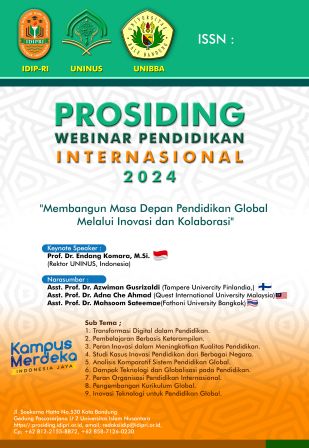ANALYSING DIAGNOSTIC ASSESSMENT ON THE TRIGONOMETRIC RATIOS
Abstract
Abstract: Trigonometry is a challenging subject. Trigonometric ratios serve as foundational material in the learning of advanced trigonometry concepts. This research aims to provide a diagnostic assessment using trigonometric ratios material and evaluate students' preparedness in handling trigonometric function information. This study used the Gravemeijer and Cobb model research design, which consists of three stages: (1) preparatory design, (2) teaching experiment, and (3) retrospective analysis. The research findings indicate that certain students cannot determine the location of the angle, the adjacent side, the opposite side, and the hypotenuse in a right triangle. Additionally, they need help correctly applying the procedure for solving trigonometric ratio problems and cannot articulate their existing knowledge. The model was constructed but needed to accurately represent the trigonometric ratios, resulting in incorrect problem-solving procedures. The majority of students need help need help to successfully handle the problems presented in strategic skills and adaptive communication. Therefore, it is necessary to provide remedial instruction before progressing to the next set of materials.
Keywords; analysing diagnostic, trigonometric ratios, constructed model
References
Akveld, M., & Kinnear, G. (2023). Improving mathematics diagnostic tests using item analysis. International Journal of Mathematical Education in Science and Technology. https://doi.org/10.1080/0020739X.2023.2167132.
Andika, R., Juandi, D., & Rosjanuardi, R. (2017). Analysing diagnostic assessment on the ratio of sine in a right triangle. Journal of Physics: Conference Series, 895(1). https://doi.org/10.1088/1742-6596/895/1/012095.
Barton, C. (2018). On Formative Assessment in Math How Diagnostic Questions Can Help. John Catt Educational. https://files.eric.ed.gov/fulltext/EJ1182085.pdf.
Behera, B. (2021). Does diagnostic evaluation in mathematics improve learners’ learning? Journal of Global Research in Education and Social Science, 15(2), 1–8. https://www.researchgate.net/publication/350459214.
Cheng, L. (2019). Diagnostic Assessments. In The TESOL Encyclopedia of English Language Teaching (pp. 1–8). John Wiley & Sons, Ltd. https://doi.org/https://doi.org/10.1002/9781118784235.eelt0493.
Dhungana, S., Pant, B. P., & Dahal, N. (2023). Students’ experience in learning trigonometry in high school mathematics: A phenomenological study. Mathematics Teaching Research Journal, 15(4), 184–201.
Fan, T., Song, J., & Guan, Z. (2021). Integrating diagnostic assessment into curriculum: a theoretical framework and teaching practices. Language Testing in Asia, 11(1). https://doi.org/10.1186/s40468-020-00117-y.
Gravemeijer, K. (2004). Learning trajectories and local instruction theories as means of support for teachers in reform mathematics education. Mathematical Thinking and Learning (Math Think Learn), 6(2), 105–128. https://doi.org/10.1207/s15327833mtl0602_3.
Harris, L. R., Adie, L., & Wyatt-Smith, C. (2022). Learning progression–based assessments: A systematic review of student and teacher uses. Review of Educational Research, 92(6), 996–1040. https://doi.org/10.3102/00346543221081552.
Ketterlin-Geller, L. R., & Yovanoff, P. (2009). Diagnostic assessments in mathematics to support instructional decision making. Practical Assessment, Research, and Evaluation, 14, 16. https://doi.org/10.7275/vxrk-3190.
Kilpatrick, Jeremy., Swafford, Jane., Findell, Bradford., & National Research Council (U.S.). Mathematics Learning Study Committee. (2001). Adding it up: Helping children learn mathematics. National Academy Press.
Kurniasih, M. D., Waluya, S. B., & Rochmad. (2020). The analysis of learning obstacle of mathematics belief. Journal of Physics: Conference Series, 1511(1). https://doi.org/10.1088/1742-6596/1511/1/012106.
Lone, R. A. (2021). Self-confidence among students and its impact on their academic performance: A systematic Review. www.ijcrt.org
Meika, I. (2018). Local Instruction Theory Kombinatorika dalam Pendekatan Pendidikan Matematika Realistik untuk Mengembangkan Kemampuan Pemodelan Matematis Siswa Sma. Universitas Pendidikan Indonesia.
Puspita, E., Suryadi, D., & Rosjanuardi, R. (2023). Learning obstacles of prospective mathematics teachers: A case study on the topic of implicit derivatives. Jurnal Matematika Kreatif-Inovatif, 14(1), 174–189.
Tang, F., & Zhan, P. (2021). Does diagnostic feedback promote Learning? Evidence From a Longitudinal Cognitive Diagnostic Assessment. AERA Open, 7. https://doi.org/10.1177/23328584211060804.
Wilson, P. H., Sztajn, P., Edgington, C., & Confrey, J. (2014). Teachers’ use of their mathematical knowledge for teaching in learning a mathematics learning trajectory. Journal of Mathematics Teacher Education, 17(2), 149–175. https://doi.org/10.1007/s10857-013-9256-1.






